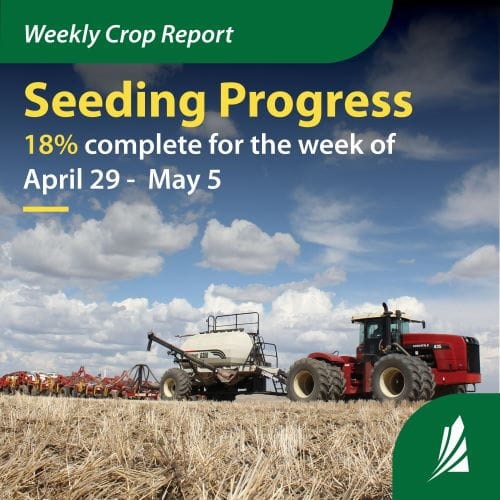The first crop report of 2025 from the Saskatchewan Ministry of Agriculture has seeding progress at 18% complete.
It's ahead of the five year average of 10 per cent and the ten year average of 12 per cent.

Despite storms around the province in April, producers have been able to get in the field and make progress over the last two weeks, especially over the last few days with the warmer weather. They've been either seeding, pre-seed spraying for weed control, harrowing and/or rock picking. Livestock producers have also been busy this spring with calving and are preparing to move cattle out to pasture.
Crops Extension Specialist with the Ministry of Agriculture Meghan Rosso says every region has made headway with the southwest the furthest ahead at 43% with some of the first seeded crops already emerging. The northwest region is at 15% seeded, the southeast at 14%, the west-central 11%, and the east-central and northeast regions report 9% of seeding completed.
Regarding crop types seeded, pulses lead the way with lentils at 34% seeded, followed by field peas at 31%, chickpeas at 28%. Durum is 33% seeded, triticale 31%, barley 19%, and spring wheat 13%. Four per cent of oats and canary seed are seeded. Mustard leads oilseed crops for seeding at 21% done, followed by canola at 10% and flax at 6%. Perennial forage is 5% seeded, and nothing to report on yet on soybeans.
Not much rain fell around the province last week with the Alida area recording the most at 16 mm and the Lafleche area 12 mm.
Rosso says topsoil moisture overall is adequate in most areas but acknowledged some areas are drier. Topsoil moisture for cropland is currently rated at 3% surplus, 78% adequate, 16% short and 3% very short. Hayland is rated at 1% surplus, 71% adequate, 22% short and 6% very short. Pasture topsoil moisture conditions are reported at 1% surplus, 68% adequate, 23% short and 8% very short.
The report says livestock producers are hoping for more moisture in the coming weeks to help with water supplies and pasture conditions in the summer. Pasture conditions, as of late April, were six per cent in excellent condition, 42 per cent good, 36 per cent fair, 13 per cent poor, and three per cent very poor.
Provincial data for the spring runoff in April showed 30 per cent below normal, 55 per cent normal and 15 per cent above normal. Most crop reporters indicated that the amount of runoff received would be enough to replenish dugouts and other water bodies within their area. But in the southwest, 52 per cent of respondents said the amount of runoff would not be enough to fill dugouts and other water bodies in that area.



